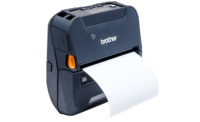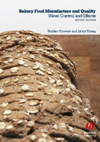Advances in snack and bakery product labeling
New technology improves printing speed, accuracy and flexibility




Advances in labeling are happening at a rapid pace. Technological leaps in marking/coding technology, printers, and labeling software have improved printing speed, accuracy and flexibility to accommodate a wide range of labels in today’s snack and bakery market. What’s more, new label printing systems enhance product appeal and better communicate information on food content.
The age of flexibility
Digital label printing is making inroads. Traditional print technologies are mature, with new machines regularly added to the field. In contrast, digital is in its early stages, with a small installed base—but with high CAGR trajectory, according to Sean Riley, senior director, media and industry communications, PMMI, Reston, VA.
Riley notes that on-demand color printing is a relatively new concept. However, as the technology improves, it’s becoming more suitable for typical snack and bakery applications. “Smaller product runs are definitely a trend, and digital allows for printing a higher level of complex art on the label and requires less prepress setup. Digital label printing brings greater efficiencies to label design and content changes through programmable software.”
In addition to recent advances that allow businesses to produce labels with more precision and at higher speeds, more focus has shifted to advances in label media. “For example, new, more-durable labels won’t smear or fade. Even water and oils no longer pose a problem with the latest media materials,” says Andrew Moore, product manager, Epson America Inc., Long Beach, CA.
The following industry trends are driving demand for more flexible label printing solutions, according to Mike Lowey, retail industry specialist, Brother Mobile Solutions. Westminster, CO:
- Rising consumer expectations. Clear labeling of all ingredients, a federal requirement, addresses concerns about allergens, healthy eating choices, desire for gluten-free products and other dietary demands. Retailers need to provide accurate, transparent labeling of all ingredients.
- Smart inventory management and tracking. Producers need to accurately track inventory to manage costs and properly forecast production needs. It is critical to produce labels on-demand that accurately capture content at the point of sale.
- Agility. Retailers and producers are looking for ways to improve flexibility and speed when featuring specials and promotions. On-demand label printing allows them to get labels on the shelves or products ASAP without the expense of ordering custom labels from a commercial printer. There also is a need to produce more labels with variable freshness dates.
Reflecting these trends, Lowey sees growing interest in new standalone solutions, such as Brother’s QuickDeploy Labeling Kits. “Retailers can use one of Brother’s lightweight mobile printers, or a stationery printer option. They simply load their Microsoft Excel file into the printer, connect the scanner via USB host port and scan barcodes to print labels. Templates can be created using our label design software, and the item file database can be updated using our Mobile Deploy application for iOS and Android devices.”
Bakeries that use clamshell containers are requesting c-wrap style labeling that allows one label to act as product identification, ingredient label and tamper evidence, according to John O’Donnell, regional sales manager, EPI, ProMach Labeling and Coding Division, New Freedom, PA. To address this need, his company offers the EPI 9220, a c-wrap labeler that applies labels to the top, front and bottom of a clamshell container, ensuring the clamshell remains closed.
Color on-demand
On-demand color printing of labels is a key market driver. In fact, an on-demand color label solution is a necessity in the snack and bakery market, according to Moore. “With on-demand label printers, businesses can cut costs and benefit from various levels of customization. Systems can accommodate the slightest changes to a product’s label without having to meet minimum print-run quantities.”
Primera printers provide flexibility for small- to mid-sized companies that want to print their own short-run labels on-demand, notes Kellie Garber, senior global product manager, Primera Technology Inc., Minneapolis. “By bringing their label production in-house, they can print only the quantity they need. This cuts down on inventory. And having a printer in-house allows for quick changes and the flexibility to print custom/seasonal designs with no lead time.”
The introduction of high-speed, full-color inkjet systems has changed the way many brands approach labeling, suggests Mike Atkins, national sales manager, Afinia Label, Chanhassen, MN. “For years, pre-printed labels that ran through thermal printers were a staple. In the last few years, we’ve seen full-color inkjet systems that produce the label faster than many single-color thermal printers. The print quality is vibrant. In addition, on-demand systems eliminate the need for large orders of labels, long lead times and waste due to pre-printed labels becoming obsolete.”
New developments in software are facilitating label creation, as well. For example, Epson offers the Wasatch SoftRIP software, which gives users the ability to spot color match. This helps businesses remain consistent in branding.
Also, software such as BarTender by Seagull Scientific, Bellevue, WA, aids in the creation of food labels that help meet regulations. “This software, paired with our ColorWorks printers, enable businesses to design, create and automate the printing of labels and barcodes,” Moore says.
With on-demand systems, printing can be as simple as pulling up a PDF and printing from a standard viewer, or as advanced as automatically populating text and images controlled by enterprise resource planning (ERP) or material requirements planning (MRP) systems, according to Atkins. “Software such as NiceLabel can pull data from orders and change label content on-the-fly. Adding a barcode scanner as an input device can further control printing on-demand and improve automation of tracking orders through a system.”
Marking and coding
Recent software advances allow manufacturers to leverage the marking and coding equipment already on their line to gain visibility into their packaging line operations, according to Chinaecherem Omenyinma, vertical marketing manager, Videojet Technologies, Chicago. “VideojetConnect, available with Videojet1580/1860 continuous inkjet printers, automates data collection for tracking of overall equipment effectiveness and finished goods data, packaging line production rates or line stops, and other operation data from across multiple packaging lines. The software gathers the data, sends it to the cloud and then returns robust reporting that identifies immediate adjustments needed to meet daily targets.”
The latest marking and coding equipment can produce quality codes as large or discreet as required while retaining the clarity to be easily readable, notes Charles Randon, senior product manager, Linx Printing Technologies, St Ives, England. “The availability of color inks for inkjet printers enables the information to complement label designs and clarifies information such as batch codes and use-by dates.”
Similarly, laser coders can deliver high-quality printing to match product branding, while laser-sensitive labels can be coded at high speeds to deliver detailed information with a quality print, notes Randon. “A coating on the label interacts with a CO2 laser coder to produce a code in a contrasting color. These high-speed labelers are faster than print and apply systems.”
Looking at future advances in labeling, Riley says that thermochromic ink, a type of dye that changes color when temperatures increase or decrease, is being considered as a quality indicator by food companies. “The creative uses for thermochromic ink make it likely that more manufacturers will begin to experiment with it, which makes it a trend that bears watching.”
Looking for a reprint of this article?
From high-res PDFs to custom plaques, order your copy today!











